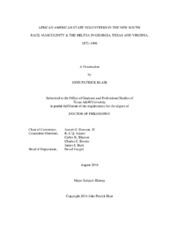| dc.description.abstract | The continued presence of armed, uniformed black militia companies throughout the southern United States from 1871 to 1906 illustrates one of the highest achievements of African Americans in this period. Granted, following emancipation the nation’s newest citizens established churches, entered the political arena, created educational and business opportunities and even formed labor organizations, but the formation and existence of these militia organizations with their inherent ability to enter into violent confrontation with the society that surrounded them coupled with the heightened status and prestige they obtained as citizen soldiers firmly defines the pinnacle of achievement. Through a comparative examination of their experiences and activities as members in the state volunteer military organizations of Georgia, Texas and Virginia, this study seeks to expand our understanding of racial accommodation and relationships during this period.
The existence of racial accommodation in society, however minor, towards the African American military is confirmed not only in the actions of state government and military officials to arm, equip and train these black troops, but also in the acceptance of clearly visible and authorized military activities by these very same troops. Further, the black militiamen themselves utilized these official displays to validate, as the nation’s newest citizens, their loyalty, discipline, and more importantly, their manliness within the public sphere.
This study also investigates other matters connected to black state militia organizations, such as “colorism,” the level of privilege or discrimination based upon the shade of one’s skin. Did black men gravitate towards the leadership of lighter-skinned members of their community and was there a perceived amount of “whiteness” that not only contributed to the acceptance of the black militia by the larger surrounding white society, but played an important role in the flexibility of the racial relationships in these three states?
The findings reveal complicated relationships between state government and military officials, many of them former Confederate officers, with the leaders of the black militia volunteers that varied across state boundaries. Furthermore, the results support the conclusion that militia participation by African Americans comprised an important component of the uplift movement centered on the manly ideal, and citizenship, and that legal actions giving rise to “Jim Crow” remained slow and, at times, made concessions to allow for continued black militia participation.
These outcomes reveal that the expression of manliness by African American militia volunteers must be considered when attempting to understand why black military participation was terminated. And, both the continued African American involvement in state military organizations until the turn of the twentieth century offsets the stereotype of black engagement coming to an end in public, or political life in the 1870s in the South and challenges when and how to classify the so-called end of Reconstruction. | en |


